




I had been on Kwajalein for a year and a half and I was overdue for another vacation. So I decided to do some travelling, and to dive some different shipwrecks. I wanted to go to Truk Lagoon (1000 miles west of Kwajalein, in the Caroline Islands) to dive some of the shipwrecks there. During World War II, Truk had been the main Japanese fleet anchorage of the central Pacific. The lagoon there now held an assortment of sunken Japanese ships that surpassed even the great fleet at Kwajalein. But Truk had been fighting a cholera epidemic for several months, and was completely unsafe to visit. The shipwrecks there would have to wait.
Just over 1500 miles southwest of Kwajalein there had been another major Japanese Naval stronghold. Rabaul, Papua New Guinea, on the island of New Britain, had been to the south Pacific what Truk had been to the central Pacific, the main Japanese Naval Base and fleet anchorage. Rabaul didn’t have a vast sunken fleet like the one at Truk, but it did have enough accessable shipwrecks to be worth a visit.
And so, in July of 1983, I spent 9 days at the small, volcano ringed town of Rabaul, P.N.G. I made 8 wreck dives on 3 ships and an airplane, and 6 dives on the incredible reefs near Rabaul.
Peter Miller, of Rabaul Dive and Tour Services PTY. arranged all of my diving, and was my dive buddy on some of the dives. I also dove with Kathy Allen, Sid and Monica Foster, Peter Ruxton, Craig Chase, Gino Tonchich, Marilyn Moore, two British guys from a copra freighter docked at Rabaul, and Debbie, Kim, and Charles, whose last names I never wrote down.
Hakkai Maru
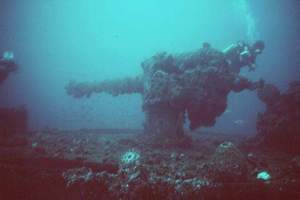 The Hakkai Maru was the biggest and best of the World War II shipwrecks at Rabaul. It was a big Japanese freighter, at least 400 ft. long, that had been converted to a repair ship. It was sunk at 5:40 PM on January 17, 1944 – skip bombed while at anchor by a U.S. Mitchell bomber. It settled upright onto the 170 ft. deep floor of Simpson Harbor.
The Hakkai Maru was the biggest and best of the World War II shipwrecks at Rabaul. It was a big Japanese freighter, at least 400 ft. long, that had been converted to a repair ship. It was sunk at 5:40 PM on January 17, 1944 – skip bombed while at anchor by a U.S. Mitchell bomber. It settled upright onto the 170 ft. deep floor of Simpson Harbor.
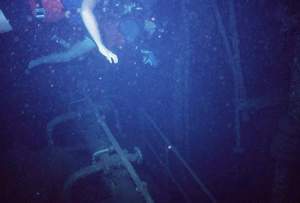 I instantly felt right at home on the Hakkai Maru, it just seemed so hauntingly familiar. The basic ship was a typical freighter, very much like “my” ships at Kwajalein. It had shadowy masts and riggings looming over dark and mysterious cargo holds, like monsterous undersea titans guarding the entrances to a deeper underworld. It held a black maze of passageways and compartments inside it’s massive, ethereal superstructure. It had the same dark glow.
I instantly felt right at home on the Hakkai Maru, it just seemed so hauntingly familiar. The basic ship was a typical freighter, very much like “my” ships at Kwajalein. It had shadowy masts and riggings looming over dark and mysterious cargo holds, like monsterous undersea titans guarding the entrances to a deeper underworld. It held a black maze of passageways and compartments inside it’s massive, ethereal superstructure. It had the same dark glow.
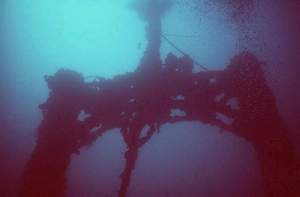 But this wasn’t just another (mostly) empty merchantman like the wrecks at Kwajalein. The Hakkai Maru’s cargo holds were full of machinery. Drills, lathes, presses, welders, and every imaginable type of metal working machines lined the decks on all levels. Equipment and materials were everywhere! Everything you might need if you had to repair a war damaged major warship at sea. It was all there, everything from hull plates to torpedoes! It was an amazing assortment of heavy metal construction implements.
But this wasn’t just another (mostly) empty merchantman like the wrecks at Kwajalein. The Hakkai Maru’s cargo holds were full of machinery. Drills, lathes, presses, welders, and every imaginable type of metal working machines lined the decks on all levels. Equipment and materials were everywhere! Everything you might need if you had to repair a war damaged major warship at sea. It was all there, everything from hull plates to torpedoes! It was an amazing assortment of heavy metal construction implements.
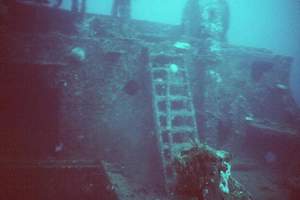 The Hakkai Maru had, in fact, been making repairs to a Japanese cruiser in the Bismark Sea just a few hours before being sunk at Rabaul Harbor. Ironically, it had sought refuge at Rabaul after the cruiser it had been repairing was sunk by Allied bombers. Forty minutes after the Hakkai Maru anchored at Rabaul the U.S. Mitchell bombers arrived there and promptly dispatched her to the bottom of the harbor.
The Hakkai Maru had, in fact, been making repairs to a Japanese cruiser in the Bismark Sea just a few hours before being sunk at Rabaul Harbor. Ironically, it had sought refuge at Rabaul after the cruiser it had been repairing was sunk by Allied bombers. Forty minutes after the Hakkai Maru anchored at Rabaul the U.S. Mitchell bombers arrived there and promptly dispatched her to the bottom of the harbor.
The Hakkai Maru was what I had been looking for. It was the quintessential shipwreck, the full experience right there in one gigantic sunken relic. This was what I had come for! To be in this towering, elegant cathedral of my deeper, darker dreams. It was inspirational. The Hakkai was a power dive!
Nonga Biplane
On my first day in New Guinea my dive guide, Peter Miller and I headed west out of Rabaul and then north. It wasn’t far to the northern New Britain coast, on the Bismark Sea. Peter said we were near Nonga, a small village that had a hospital run by nuns. We stopped next to the shore and put on all our dive gear except masks and fins. To get to the deep water we had to hike across a submerged reef that averaged about a foot and a half underwater. It was at least a hundred yards to the edge, where we put on our masks and fins and dropped off into the deep, blue water. The weightlessness of the ocean was a welcome relief after sloshing through the water on the sharp, uneven coral, weighted down with an air tank and all the rest of my gear. It sure felt good to be back in the ocean. The water was bright and clear.
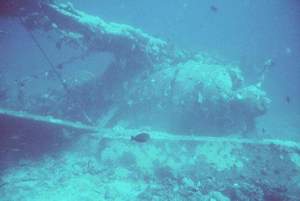 A short swim along the sandy bottom brought us to a Japanese airplane, a relic of World War II. It was a Misubishi F1M biplane sitting upright on the ocean floor, 90 ft. deep. It was almost completely intact! Or at least as intact as an airplane could be after spending about 40 years on the bottom of the ocean. The fuselage, wings, engine, pontoons, and propeller were all where they should be. The cockpit even had some of it’s instruments and controls still in place.
A short swim along the sandy bottom brought us to a Japanese airplane, a relic of World War II. It was a Misubishi F1M biplane sitting upright on the ocean floor, 90 ft. deep. It was almost completely intact! Or at least as intact as an airplane could be after spending about 40 years on the bottom of the ocean. The fuselage, wings, engine, pontoons, and propeller were all where they should be. The cockpit even had some of it’s instruments and controls still in place.
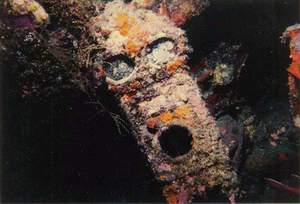 The reason the plane was in such good shape was it hadn’t been shot out of the sky in battle. It had been floating there, anchored just off the reef, when it was strafed by an American plane. It’s punctured pontoons had allowed it to sink and then gently settle into the sand at the bottom of the Bismark Sea.
The reason the plane was in such good shape was it hadn’t been shot out of the sky in battle. It had been floating there, anchored just off the reef, when it was strafed by an American plane. It’s punctured pontoons had allowed it to sink and then gently settle into the sand at the bottom of the Bismark Sea.
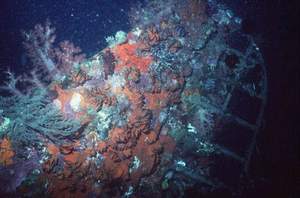 The whole thing was coated with thin, red sponges, the kind that sometimes cover the smooth surfaces underwater the way lichens cover smooth stone above. And small forests of flowing soft corals were growing on the fuselage and wings, along with a few zig-zag clams.
The whole thing was coated with thin, red sponges, the kind that sometimes cover the smooth surfaces underwater the way lichens cover smooth stone above. And small forests of flowing soft corals were growing on the fuselage and wings, along with a few zig-zag clams.
It was an excellent dive. I had been at Rabaul for less than 24 hours and had already been diving. I loved Rabaul.
For more info please visit www.thunderstruckobservatory.com/ships.html